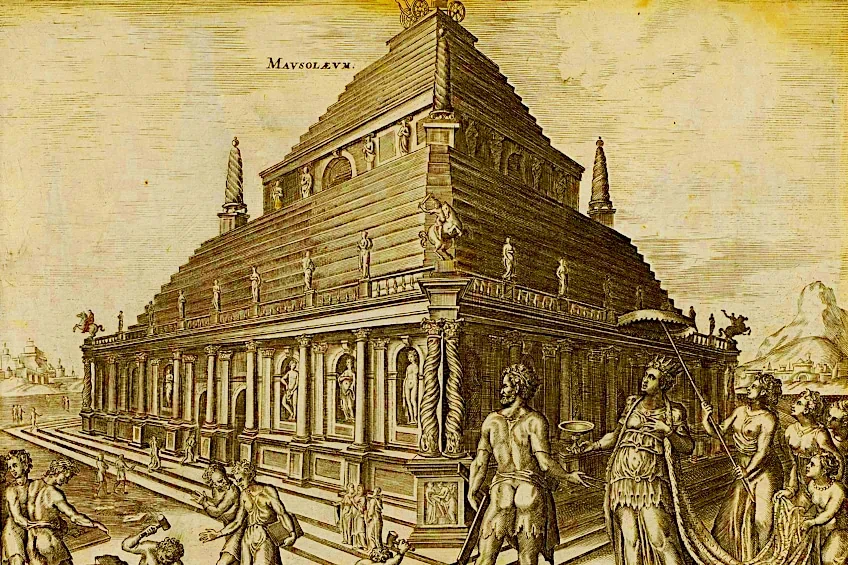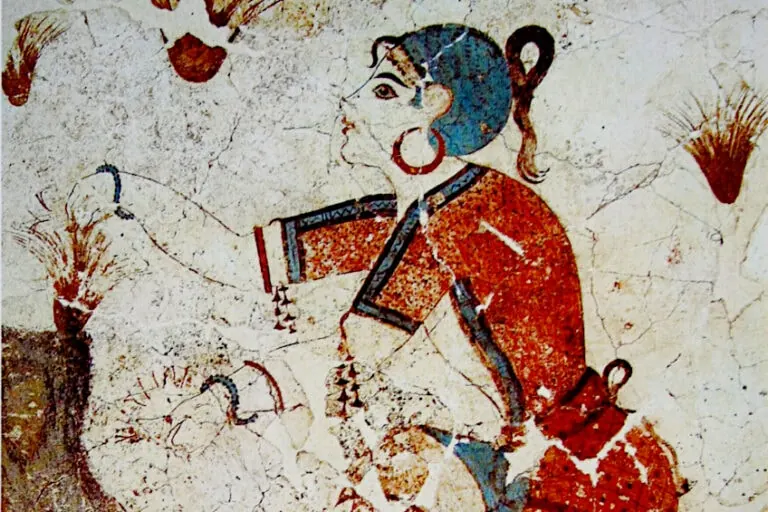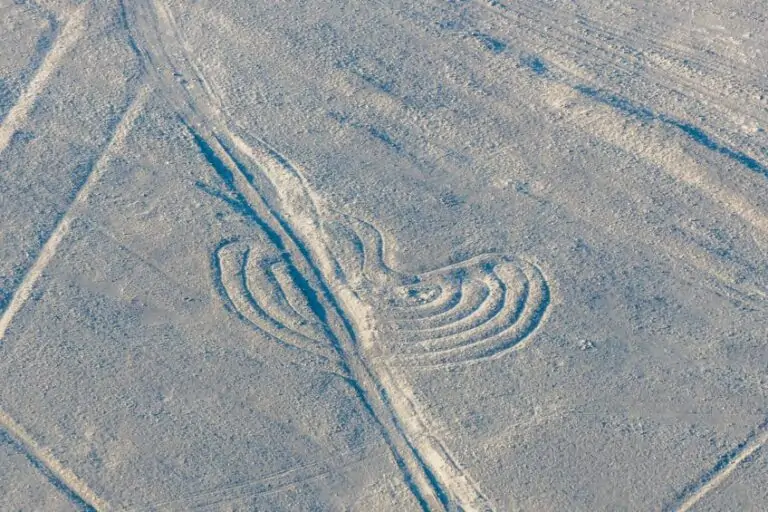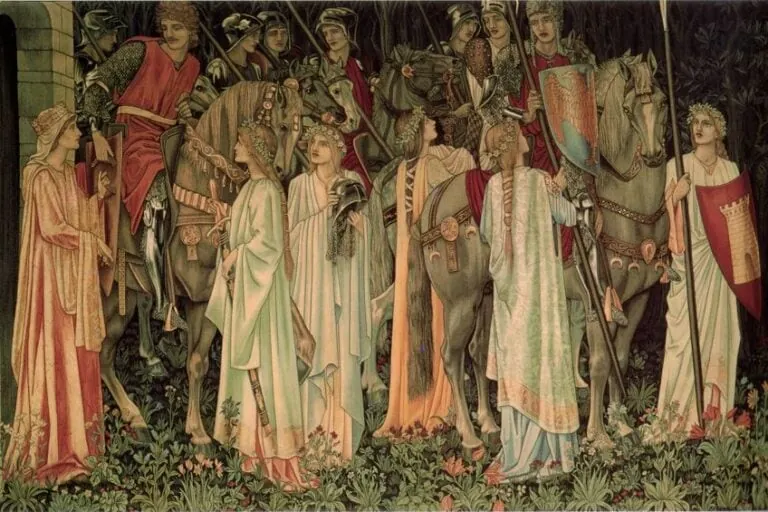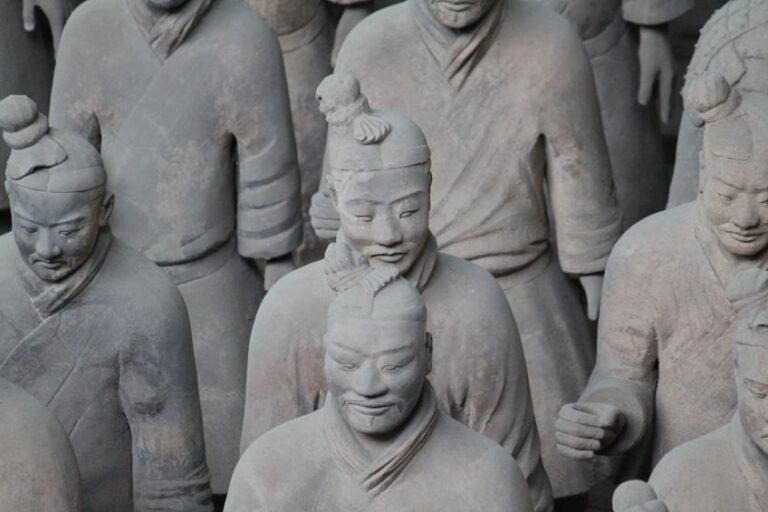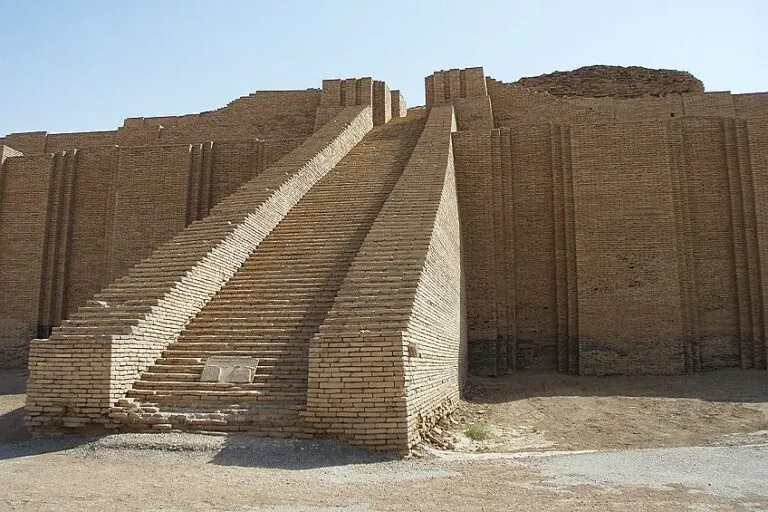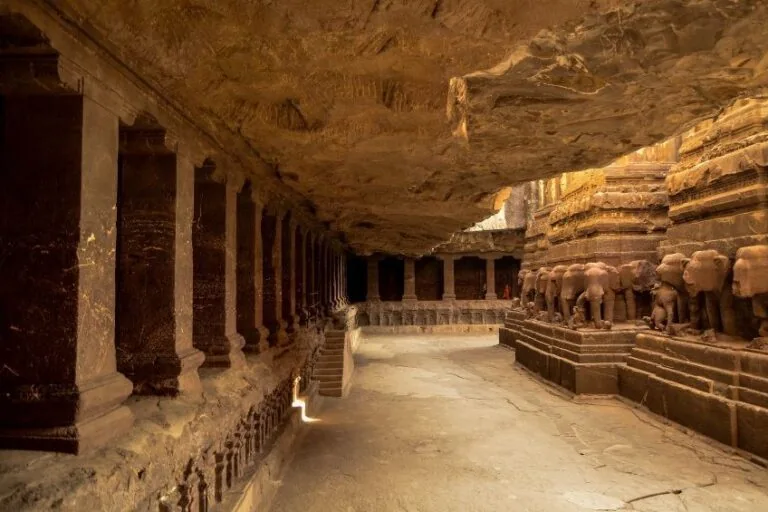Mausoleum at Halicarnassus – The Wonderous Tomb of Mausolus
One of the Seven Wonders of the Ancient World was the Mausoleum at Halicarnassus, and it acted as the Tomb of Mausolus. You may have several questions about this gorgeous marvel of the ancient world, and those questions will be answered. Questions such as “where was the Mausoleum at Halicarnassus built?,” “what were the Mausoleum at Halicarnassus statues?,” and “what was the Mausoleum at Halicarnassus built for?” will be answered. We will also look at who Mausolus was and whether he deserved a tomb that would go on to become one of the Seven Wonders of the Ancient World. Read on to see if he did deserve such fame.
Contents
A Look at the Mausoleum at Halicarnassus
| Architect | Satyros and Pythius of Priene (both 4th century BCE) |
| Date Constructed | 353 – 350 BCE |
| Function | Tomb |
| Location | Bodrum, Turkey |
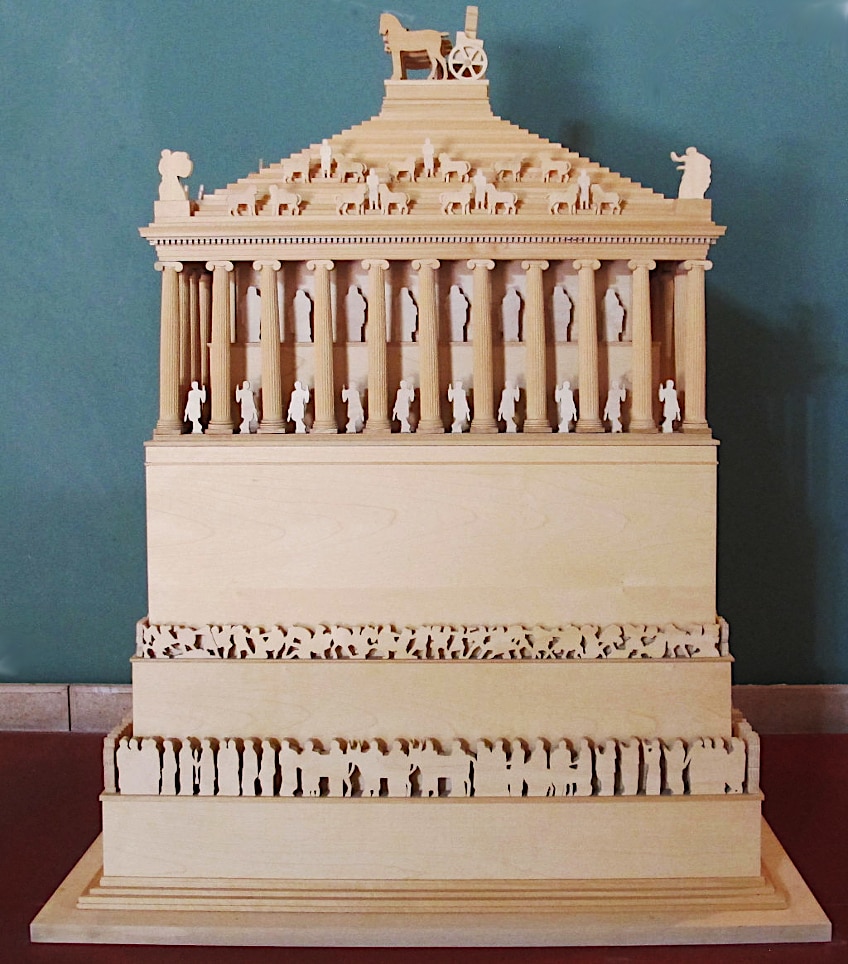 Reconstruction Model of the Mausoleum at Halicarnassus; I, Sailko, CC BY-SA 3.0, via Wikimedia Commons
Reconstruction Model of the Mausoleum at Halicarnassus; I, Sailko, CC BY-SA 3.0, via Wikimedia Commons
The Mausoleum at Halicarnassus, which is also known as the Tomb of Mausolus, was a tall and ornate structure that used to stand in the city of Halicarnassus, which was once the capital city of Caria. This city was simply one component part of the Achaemenid Empire. However, this city no longer exists and in its place, you can instead find the city of Bodrum, Turkey. A city with hundreds of years of its own history that, nevertheless, no longer holds one of the Seven Wonders of the Ancient World.
The ancient capital city was home to this ornate tomb, and it was considered to be one of the most beautiful structures in the entire known world. This ancient wonder no longer exists, and, in its place, there is little more than rubble and a few additional parts, such as a few broken statues. The once grand mausoleum has long since vanished and none are entirely certain of all the information to do with this monument.
The reason that we cannot know various things about this ancient mausoleum is that, as a truly ancient structure that was built over 2000 years ago, few truly reliable records exist that discuss the Tomb of Mausolus. It is famous for having been listed as one of the seven wonders of the ancient world. Much of the information we have about the Mausoleum at Halicarnassus comes from the Ancient Greek scholar Pliny the Elder. This was a man who may have written a lot about the world he knew, but he was not necessarily an expert in many of the things that he wrote about. He was not an architect, yet he wrote on architecture, so what he wrote should often be taken with a grain of salt.
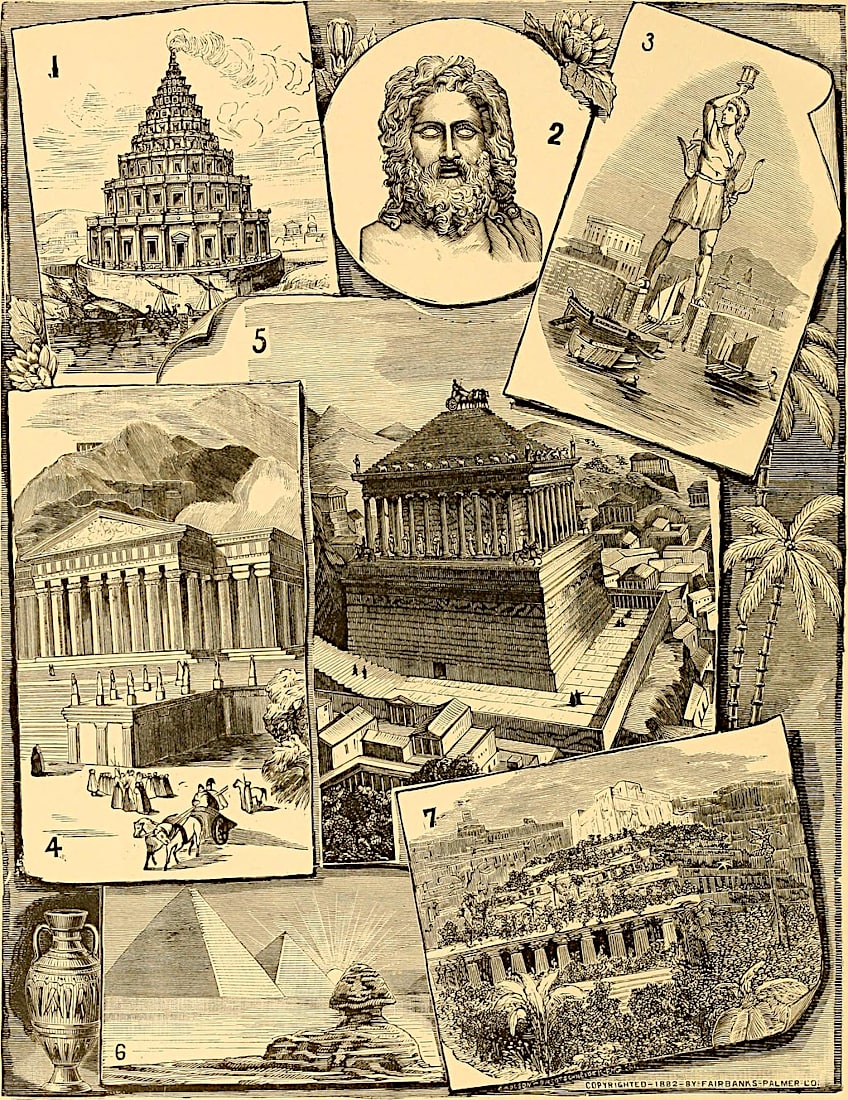 Illustration depicting the Seven Wonders of the Ancient World. 1—Lighthouse of Alexandria. 4—The Temple of Artemis at Ephesus. a—Statue of the Zeus at Olympia. 5—The Tomb of Mausolus. 3—The Colossus at Rhodes. 6—The Great Pyramid of Giza. 7—The Hanging Gardens of Babylon from The world: historical and actual by Frank Gilbert (1886); Internet Archive Book Images, No restrictions, via Wikimedia Commons
Illustration depicting the Seven Wonders of the Ancient World. 1—Lighthouse of Alexandria. 4—The Temple of Artemis at Ephesus. a—Statue of the Zeus at Olympia. 5—The Tomb of Mausolus. 3—The Colossus at Rhodes. 6—The Great Pyramid of Giza. 7—The Hanging Gardens of Babylon from The world: historical and actual by Frank Gilbert (1886); Internet Archive Book Images, No restrictions, via Wikimedia Commons
Despite the lack of truly definitive information, we do know several things about this ancient monument. This article will look at what we do know, and, hopefully, there’s more than enough here to inform you about this ancient Wonder of the World known as the Mausoleum at Halicarnassus.
Where Was the Mausoleum at Halicarnassus Built?
The Mausoleum at Halicarnassus was built, as the name would suggest, in Halicarnassus. This city was the seat of power of Mausolus and his rule over the kingdom known as Caria. This area is in modern-day Turkey and the city has been replaced with the city of Bodrum. This city is not necessarily the same city as it was extensively rebuilt and the original structures do not exist. Even the original structure of the Mausoleum at Halicarnassus does not exist in any real state anymore.
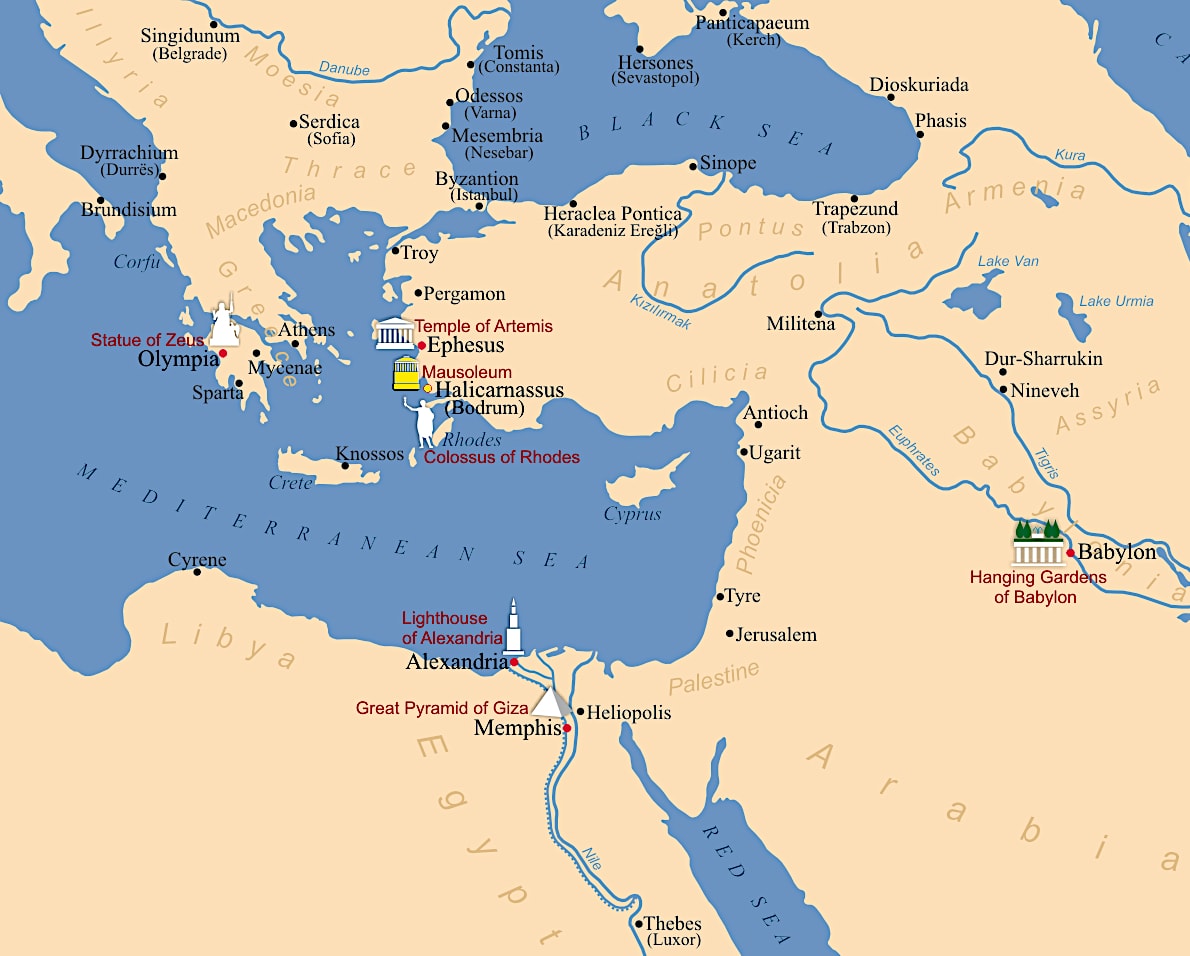 Location of the Mausoleum at Halicarnassus relative to the other Seven Wonders of the Ancient World; Kandi, CC BY-SA 3.0, via Wikimedia Commons
Location of the Mausoleum at Halicarnassus relative to the other Seven Wonders of the Ancient World; Kandi, CC BY-SA 3.0, via Wikimedia Commons
This elevated structure was built on a hill overlooking the ancient city of Halicarnassus, and it was built in a style reminiscent of the nearby state of Lycia. This state became part of the kingdom of Caria after Mausolus invaded and annexed the country. He did this in 360 BCE. This may give a good indication of just how old this structure is, and where some of its influence may have come from, but what did it use this influence to accomplish? How did the Mausoleum at Halicarnassus establish itself as an architectural Wonder of the Ancient World?
What Was the Architecture of the Mausoleum at Halicarnassus?
The basic dimensions of the Mausoleum at Halicarnassus are as follows: it had a tomb that was 13 m tall, a colonnade that was 12 m tall, a quadriga that was 6 m tall, and, lastly, a roof that was 12 m tall. Each of these was built atop the next to bring the whole structure to a heightened stature above the city. The Mausoleum at Halicarnassus was also built on top of a large slab, so it stood with a total height of 45 m (or 148 ft).
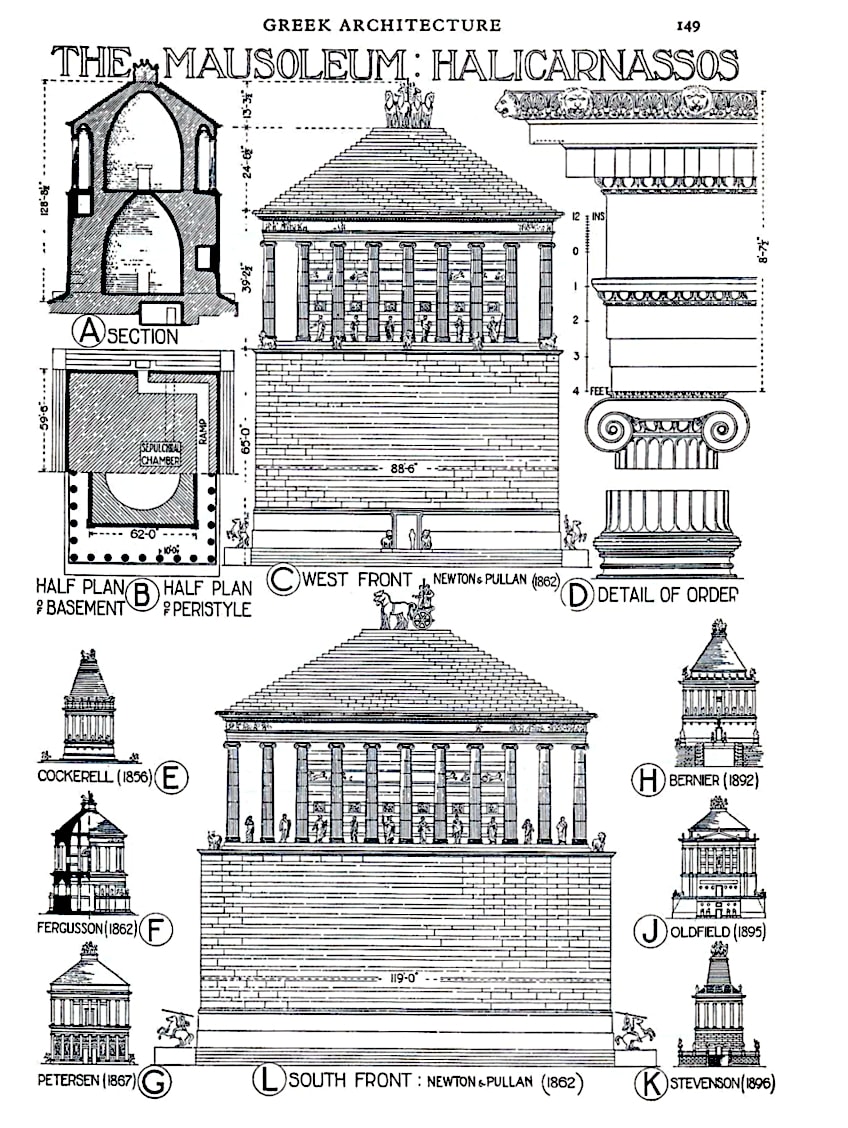 Architectural plans by various scholars of the Mausoleum at Halicarnassus; Sir Banister Flight Fletcher (15 February 1866, London – 17 August 1953, London), Public domain, via Wikimedia Commons
Architectural plans by various scholars of the Mausoleum at Halicarnassus; Sir Banister Flight Fletcher (15 February 1866, London – 17 August 1953, London), Public domain, via Wikimedia Commons
By today’s standards, this does not make the Mausoleum at Halicarnassus a particularly large structure. In fact, it was not considered to be a particularly large structure at the time of its construction either. It was certainly far taller than anything else in that particular city, and because of its elevated position, it was even taller than it may have otherwise appeared. But this does not mean that it was all that tall.
The height of the Mausoleum at Halicarnassus was not the thing that made it such a glorious monument. The height was only impressive in juxtaposition with everything around it, and by modern architectural standards, this old tomb could easily be supplanted by any number of apartment buildings, never mind true skyscrapers.
The stone platform that elevated the Mausoleum at Halicarnassus gave way to a staircase that was flanked by stone lions that watched over the Tomb of Mausolus. They were eternal guardians alongside the stone warriors on horseback. Each of them guarded the various murals on the walls that depicted the iconography of numerous gods and goddesses. The Mausoleum at Halicarnassus was intended as a place of the highest artistry.

Moldings from the Mausoleum at Halicarnassus with their original colors (1864); Newton, C. T. (Charles Thomas), 1816-1894; Pullan, Richard Popplewell, 1825-1888, Public domain, via Wikimedia Commons
The tomb itself was made of marble and 36 columns adorned the structure. The whole thing was surrounded by sculpted reliefs depicting various mythical battles that were part of the Greek tradition that Mausolus was not a member of, but rather an admirer of. His tomb, with its pyramidal roof, overlooked the eventual destruction that the capital city would face as the centuries rolled through the world.
At the apex of the pyramid-shaped roof, a horse-drawn carriage stood. That chariot contained a sculpture of Mausolus and Artemisia II, his wife. The pair of them would, theoretically, forever remain in this elevated position, but that was not meant to last. At the time, it certainly would have seemed like something that would last through the ages though.
This monument was considered to be one of the most beautiful in the world. Not only because of the architectural design of the tomb itself but because of the over 400 free-standing statues that adorned the place. They captured the attention of all who visited.
What Are the Mausoleum at Halicarnassus Statues?
The Mausoleum at Halicarnassus was once full of statues. Sadly, they have not been preserved and comparatively few of them remain in any form whatsoever. However, at one time there were over 400 such statues. They included four marble chariots, over 20 lions, and various larger-than-life humanoid statues, such as the soldiers that flanked the tomb. There was also a semi-colossal female head that was found.
The various sculptures that surrounded this old ruin were created by several different Greek sculptors who were brought to Caria for the express purpose of creating the most beautiful tomb that Mausolus could have dreamed of, and those Ancient Greek sculptors were as follows: Leochares, Bryaxis, Scopas of Paros, and Timotheus.
By today, these sculptors may not be at the height of their fame, but, at the time, they were considered the greatest in their class alongside the architects Satyros and Pythius of Priene who were brought in to ensure that the Mausoleum at Halicarnassus stood as a triumph above all others.
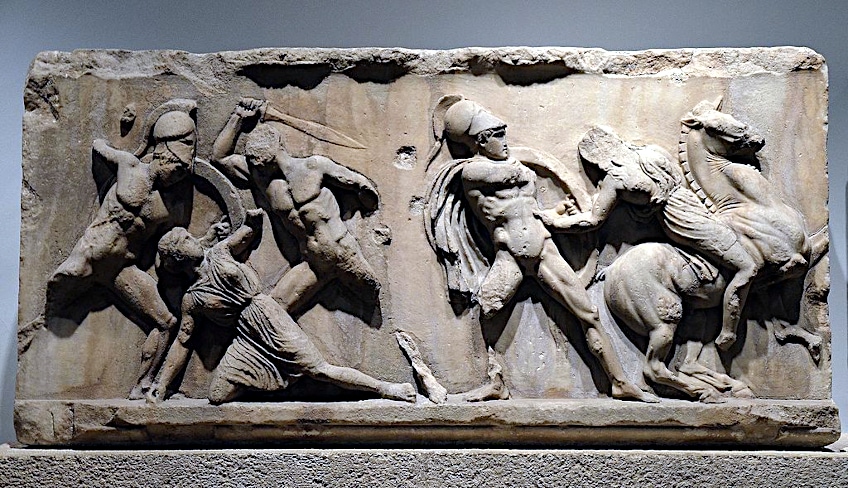 Frieze depicting the Amazonomachy from the Mausoleum at Halicarnassus; Carole Raddato from FRANKFURT, Germany, CC BY-SA 2.0, via Wikimedia Commons
Frieze depicting the Amazonomachy from the Mausoleum at Halicarnassus; Carole Raddato from FRANKFURT, Germany, CC BY-SA 2.0, via Wikimedia Commons
The Mausoleum at Halicarnassus was designed to be larger than life, and a projection of the power of Mausolus. These statues do not really exist any longer, although two of the statues that have been recovered are said to be representations of Mausolus and Artemisia II. However, we cannot be entirely certain that this is the case as there are no real records.
In addition, the statue that was once atop the roof of the Mausoleum at Halicarnassus no longer exists in a fully formed capacity. We only know of much of this through first-hand accounts at the time and second-hand accounts from similarly ancient times, such as from the writings of the ancient Roman architect Vitruvius. The ancient statues that surrounded the Mausoleum at Halicarnassus are lost to time, but why the tomb was built is not something that was lost.
 Colossal statue of a man, traditionally identified with Mausolus, king of Caria, from the north side of the Mausoleum at Halicarnassus (c. 350 BCE); Carole Raddato from FRANKFURT, Germany, CC BY-SA 2.0, via Wikimedia Commons
Colossal statue of a man, traditionally identified with Mausolus, king of Caria, from the north side of the Mausoleum at Halicarnassus (c. 350 BCE); Carole Raddato from FRANKFURT, Germany, CC BY-SA 2.0, via Wikimedia Commons
What Was the Mausoleum at Halicarnassus Built For?
The Mausoleum at Halicarnassus was constructed as the Tomb of Mausolus. This tall, ancient monument was meant to serve as an eternal, glorious tribute to the man. In a sense, the decision to make a structure such as this appears to be somewhat divinely inspired, as if there was an attempt to literally elevate the man to a godlike status, perhaps in a similar sense to the pyramids in Egypt.
The tomb may have been dedicated to Mausolus, but you should understand who exactly Mausolus was if you want to understand why he was seemingly so deserving of a structure as publicly magnificent as this. It has already been stated that Mausolus was a leader, and he must have been a great leader to deserve a tomb such as this, but who exactly was he and what did he do?
Who Was Mausolus?
The Mausoleum at Halicarnassus was ultimately constructed as the tomb of Mausolus, so who was Mausolus? He was a satrap. This is a kind of regional governor in the Achaemenid Empire. However, it may be best to think of him as a king as he did wield the kind of power that one might expect of a king from that time.
Mausolus was not actually a Greek but a Carian. However, he had a love and appreciation for Greek culture and for the Greek way of life, and so, in many ways, he wished to emulate it. This is why there are so many Ancient Greek architects and sculptors who worked on the Mausoleum at Halicarnassus.
Mausolus was also a conqueror. He desired expansion. So, during his reign, he attempted to expand his reach. The most notable area where his reach soon extended was into Lycia, and it was in Lycia where the inspiration for a tomb like the Mausoleum at Halicarnassus was discovered, as Lycia contains many ornate tombs, such as Tombs at Xanthos.
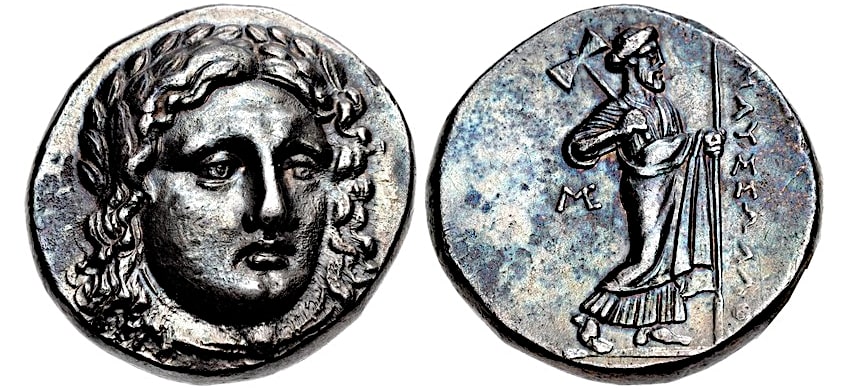 Coin depicting the Satraps of Caria with text identifying “Maussolos” (c. 377/6 – 353/2 BCE); Classical Numismatic Group, Inc. http://www.cngcoins.com, CC BY-SA 3.0, via Wikimedia Commons
Coin depicting the Satraps of Caria with text identifying “Maussolos” (c. 377/6 – 353/2 BCE); Classical Numismatic Group, Inc. http://www.cngcoins.com, CC BY-SA 3.0, via Wikimedia Commons
This ancient ruler actually ruled alongside his wife, and sister, Artemisia II. The two of them had no children and so there are theories that their marriage was, in some sense, more ceremonial than romantic. However, legend holds that when he died her grief was so great that she drank a mixture containing his ashes daily. The pair of them would together rule with an iron fist, and Mausolus was known to be an authoritarian tyrant who even went so far as to punish nobles who worked against him in any way.
He may have been a tyrannical figure in life, but he managed to secure his legacy in death. Since he did not leave behind any children, his line was not perpetuated, but the Mausoleum at Halicarnassus can perhaps be seen as the child he left behind. It was known far and wide, but what was its history? How did it become what it was in the ancient world, and how did it become the rubble that it is today?
The History of the Mausoleum at Halicarnassus
Halicarnassus was once just the capital of Caria. This small kingdom was part of the far larger Achaemenid Empire. This small kingdom fell into the hands of Mausolus after his father passed away. Mausolus began his career as the ruler of this state by expanding his reach. He entered Anatolia and, especially, the Lycia territory. As previously mentioned, it was here that he saw what he wanted for his tomb, but he was never actually able to finish that tomb. Instead, he died before construction could even truly get underway. It was his wife Artemisia who would oversee the construction of this monument to Mausolus.
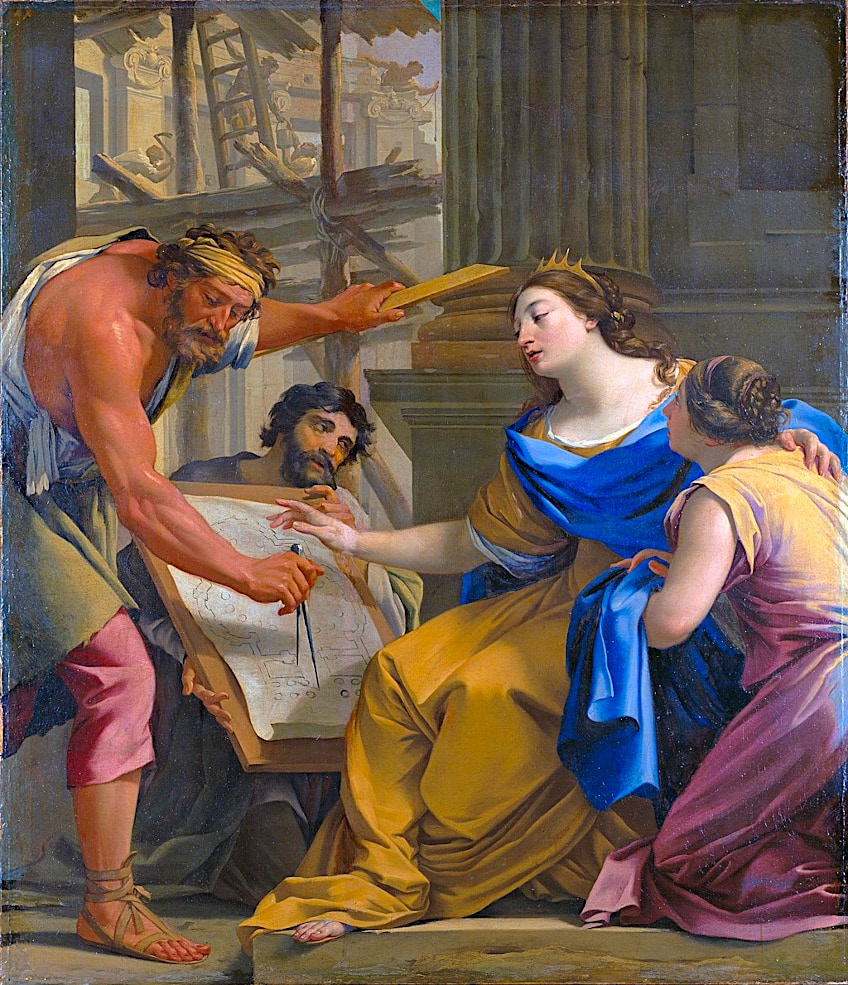 Artemisia Building the Mausoleum by Simon Vouet (early 1640’s); Simon Vouet, Public domain, via Wikimedia Commons
Artemisia Building the Mausoleum by Simon Vouet (early 1640’s); Simon Vouet, Public domain, via Wikimedia Commons
There is evidence to suggest that Mausolus would have been alive during some level of planning and construction, but the main bulk of the work was under Artemisia II. She would take his love of Greek culture and life and ensure that it was infused into the tomb. Sadly, despite sparing no expense and finding the best artists that the Greek world possessed, Artemisia II did not survive to see it completed either.
The Mausoleum at Halicarnassus was completed, and it became the tomb of both rulers of Caria. It was the resting place of both Mausolus and Artemisia II, and the statue of the pair of them in a horse-drawn carriage atop the pyramidal roof would signify that fact for all to see. They would forever watch over this place.
How Long Did the Mausoleum at Halicarnassus Survive?
The Mausoleum at Halicarnassus lasted a long time. This tomb withstood many events from history. For instance, it survived an attack from Alexander the Great and a bunch of pirate attacks. This tomb stood as a seemingly eternal reminder of the strength and power that Mausolus had managed to attain throughout his life. However, this was not as eternal as it may have appeared at first.
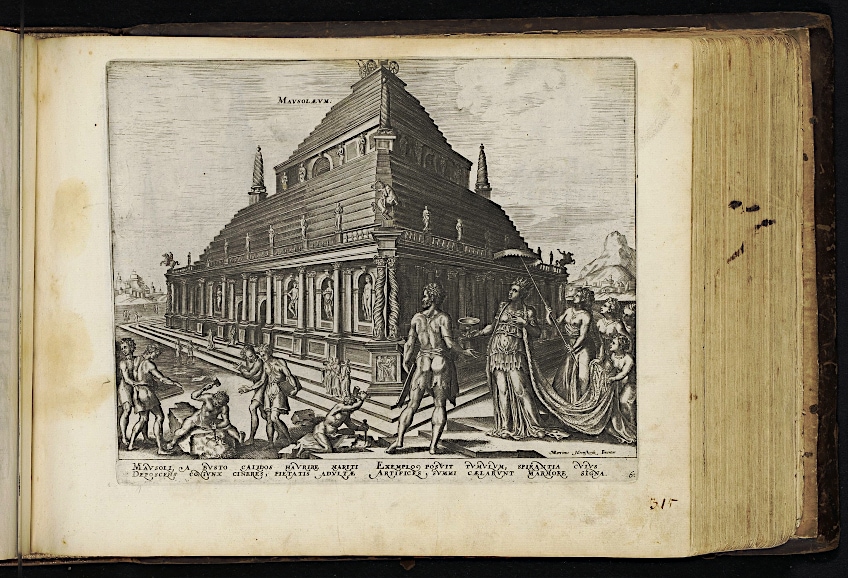 The Mausoleum of Halicarnassus from Van de Seven Wonderen der Wereldt (1572 and/or 1646); Rijksmuseum, CC0, via Wikimedia Commons
The Mausoleum of Halicarnassus from Van de Seven Wonderen der Wereldt (1572 and/or 1646); Rijksmuseum, CC0, via Wikimedia Commons
The Mausoleum at Halicarnassus was standing during the 12th century and it was no longer standing by the 15th century. We know this because, in the 12th century, Eustathius of Thessalonica, a Greek scholar, recorded that it was still a Wonder of the World. However, by the time the Knights of St John of Jerusalem claimed the area in 1402, the Mausoleum at Halicarnassus was little more than a ruin.
It is presumed that there were various earthquakes during this time that led to the ultimate destruction of this ancient tomb. There are no local writings of its destruction, so the Mausoleum at Halicarnassus may have actually fallen even earlier, but it certainly was one the Wonders of the Ancient World that lasted the longest, providing you exclude the still-standing Great Pyramid at Giza.
By the 19th century, only the foundations and some broken statues remained. The site even saw graverobbers at various points. In fact, the site was nearly forgotten, as archaeologists from the British Museum had to search for it. The Mausoleum at Halicarnassus was nearly entirely lost to time.
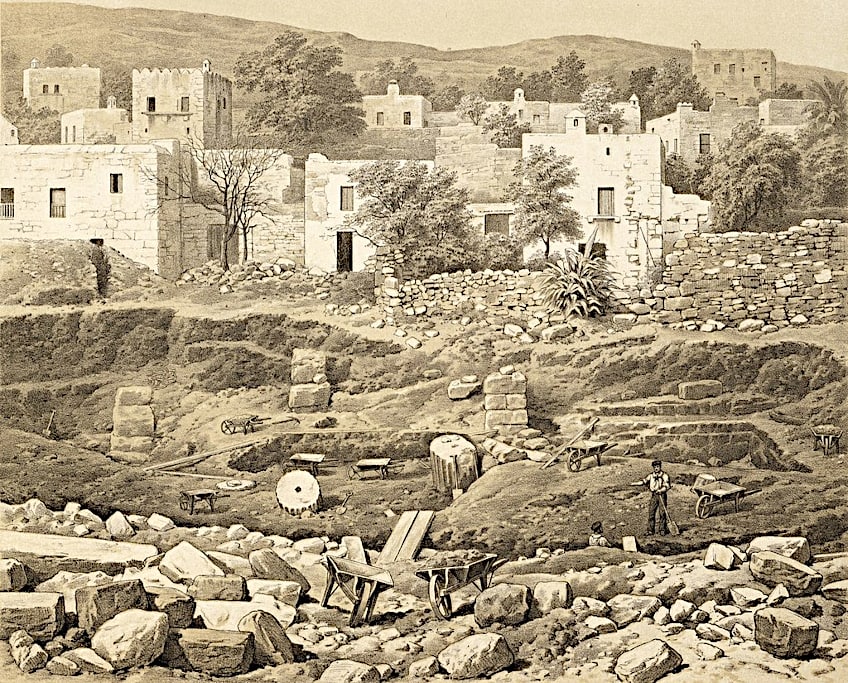 Mausoleum of Halicarnassus excavation of north side of quadrangle by Thomas Picken (1862); Thomas Picken d.1891 after B Spackman R.E., Public domain, via Wikimedia Commons
Mausoleum of Halicarnassus excavation of north side of quadrangle by Thomas Picken (1862); Thomas Picken d.1891 after B Spackman R.E., Public domain, via Wikimedia Commons
What Can You Do At the Mausoleum of Halicarnassus Today?
If you want to visit the Mausoleum at Halicarnassus today, you still can. There is a small museum at the site, but the actual ruins contain little more than a foundation. However, there are guided tours that you can join if you want to see them for yourself anyway. In addition to this, there are fragments of statues and a frieze in the British Museum.
If you want to see more of the Mausoleum at Halicarnassus itself, you have to go to the castle in Bodrum where the Knights of St John of Jerusalem took various slabs of stone and numerous sculpted segments. So, you can still find some pieces of it built into the walls of the castle. Sadly, you cannot see them in their original position.
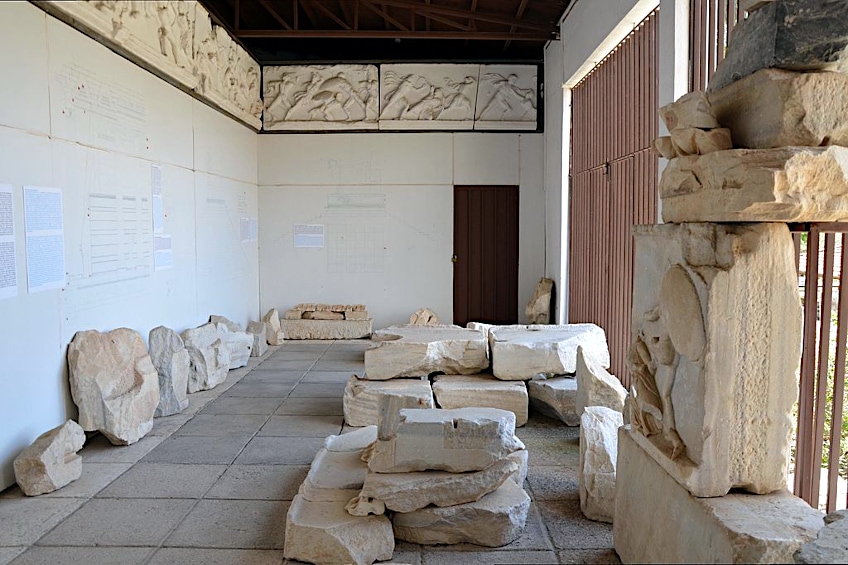 Display of remnants from the Mausoleum of Halicarnassus in Bodrum, Turkey; Carole Raddato from FRANKFURT, Germany, CC BY-SA 2.0, via Wikimedia Commons
Display of remnants from the Mausoleum of Halicarnassus in Bodrum, Turkey; Carole Raddato from FRANKFURT, Germany, CC BY-SA 2.0, via Wikimedia Commons
Although, that does not mean that the influence of the Mausoleum at Halicarnassus cannot be seen. Various structures have been influenced in some way by the Tomb of Mausolus. For instance, Grant’s Tomb in New York City, St George’s Church in London, and the National Diet in Tokyo. The Mausoleum at Halicarnassus was an amazing structure, and its influence stretches across the world.
Some Mausoleum at Halicarnassus Facts
- The Mausoleum at Halicarnassus was such an influential structure that it led to the creation of a new word entirely. Mausoleum, as a word, came from this structure. It came from the name of Mausolus. When a term, that was once a proper noun, becomes a generic term, you know that it is influential. In the modern-day, the most famous mausoleum in the world is very likely the Taj Mahal.
- When the Knights of St John of Jerusalem came to the Mausoleum at Halicarnassus, they took stones from the ancient tomb for their own castle. In addition, this order even removed reliefs from the tomb, and they decorated their own structure with them. This is one of the ways in which the Mausoleum at Halicarnassus eventually disappeared.
- Much of the marble that was used in the Mausoleum at Halicarnassus is no longer there. While the sculptures may have been taken and displayed, the marble was ground down, burnt, and turned into lime. This is because lime can be used as plaster. So, pieces of the Mausoleum at Halicarnassus are likely all over the modern city of Bodrum.
The Mausoleum at Halicarnassus was one of the Seven Wonders of the Ancient World. It was a truly magnificent sight to behold. It did ultimately fall to utter ruin and there is no longer any way to know for certain what was contained within its walls, but we can know the history of this ancient tomb. We know why it was built, where it was built, and that it was considered to be such an architectural marvel that it was revered throughout the ancient world. However, this is all that we know. Or at least this is all that we know until an ancient document appears that reveals new information, but it may not be worth hanging around and waiting for something like that to appear.
Frequently Asked Questions
Where Was the Mausoleum at Halicarnassus Built?
The Mausoleum at Halicarnassus was, as the name may suggest, situated in the ancient Persian city of Halicarnassus. However, this city no longer exists as it once did. In its place, you can now find the modern-day Turkish city of Bodrum. The structure does not exist in any real capacity any longer, but the ruins can still be visited.
What Are the Mausoleum at Halicarnassus Statues?
The Mausoleum at Halicarnassus is considered to be one of the Seven Wonders of the Ancient World, and it wasn’t only because of the architecture. The Mausoleum at Halicarnassus was absolutely covered in a variety of statues and sculptures. There were over 400 of these, and many of them were free-standing. They depicted various things, such as animals, chariots, and soldiers. Unfortunately, most have been destroyed or lost to time.
What Was the Mausoleum at Halicarnassus Built For?
The Mausoleum at Halicarnassus was built as the Tomb of Mausolus. The word mausoleum has become a common term, but it comes from his name. He was a powerful and tyrannical leader who managed to secure his place in eternal history by ordering the construction of one of the greatest tombs ever built.
When Was the Mausoleum at Halicarnassus Destroyed?
We do not know for certain when the Mausoleum at Halicarnassus was destroyed, but it was the longest-lasting of the Seven Wonders of the Ancient World, aside from the Great Pyramid at Giza. However, it fell at some point between the 12th and 15th centuries. It may have been destroyed by an earthquake, but there is no way to know for certain as there are no records of its destruction.
What Were the Other Seven Wonders of the Ancient World?
Only one of the Seven Wonders of the Ancient World still exists mostly unscathed, and that is the Great Pyramid at Giza. The others, aside from the Mausoleum at Halicarnassus, include the Lighthouse of Alexandria, the Statue of Zeus at Olympia, the Hanging Gardens of Babylon, the Temple of Artemis, and the Colossus of Rhodes.

I am deeply passionate about history and am constantly fascinated by the rich and complex stories of the past. As the editor-in-chief of learning-history.com, I have the opportunity to share this passion with a wide audience through the creation and distribution of engaging and informative content about historical events, persons, and cultures. Whether it’s through writing articles and blog posts or creating videos or podcasts, I strive to bring the past to life in a way that is both accurate and enjoyable. My expertise in history, combined with my strong writing and communication skills, allows me to effectively communicate complex historical concepts and make them accessible and interesting to a wide range of readers. I am truly grateful for the opportunity to share my love of history with others through my work on learning-history.com.

